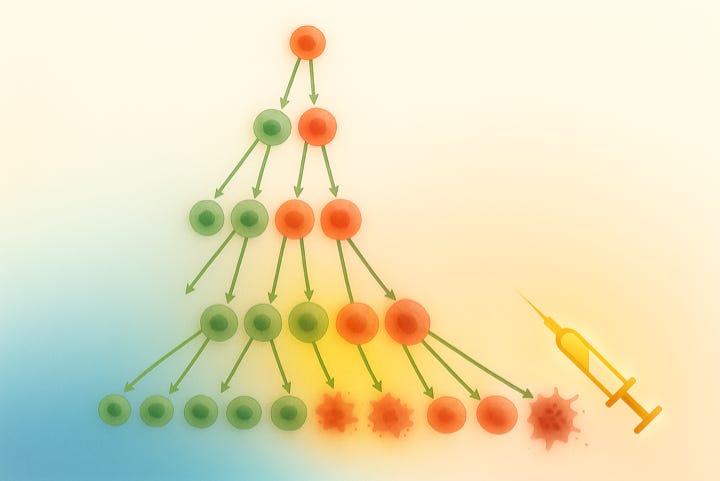This week in MathOnco 351
Immune evasion, cancer growth, vascularization, oncolytic virotherapy, and more...
“This week in Mathematical Oncology” — Nov 13, 2025
> mathematical-oncology.org
From the editor:
We’re back with another edition of the mathematical oncology newsletter, this time on immune evasion, cancer growth, vascularization, oncolytic virotherapy, and more...
It was so awesome to meet many of you at the MathOnco25 conference and the IMO Workshop. Stay in touch, and send me your papers!
Enjoy,
Jeffrey West
jeffrey.west@moffitt.org
Epigenetically driven and early immune evasion in colorectal cancer evolution
Eszter Lakatos, Vinaya Gunasri, Luis Zapata, Jacob Househam, …, John Bridgewater, Ann-Marie Baker, Andrea Sottoriva & Trevor A. GrahamComparing partial differential equations and agent-based simulations in spatio-temporal modeling of cancer growth and shape
Teddy Lazebnik, Avner FriedmanQuantitative systems toxicology: modelling to mechanistically understand and predict drug safety
Christopher E. Goldring, Giusy Russomanno, Carmen Pin, Panuwat Trairatphisan, …, Jeffrey A. Willy, Derek J. Leishman, James L. Stevens, Loic LaplancheA Mechanistic Model of Brain Necrosis Progression Based on Vascular Heterogeneity
Nicolò Cogno, Keyur D. Shah, Felix Ehret, Chris Beekman, …, Wesley E. Bolch, Helen A. Shih, Harald Paganetti, Ibrahim ChamseddineMathematical modelling of tumor-immune interactions in breast cancer
Haifeng Zhang, Chenghang Li
The role of viral dynamics and infectivity in models of oncolytic virotherapy for tumours with different motility
David Morselli, Federico Frascoli, Marcello DelitalaMethods for inferring coalescent tree topologies from genomic data: a comparison based on the transmission of reproductive success
Fanny Pouyet, Ferdinand Petit, Jérémy Guez , Léo Planche (1) , Evelyne Heyer (3) , Bruno Toupance (3) , Flora Jay (2, 4) , Frédéric Austerlitz (3)Agent-based simulations of lung tumour evolution suggest that ongoing cell competition drives realistic clonal expansions
Helena Coggan, James R. M. Black, Carlos Martínez-Ruiz, Kristiana Grigoriadis, Jasmin Fisher, View ORCID ProfileNicholas McGranahanA memory-driven reinforcement learning model of phenotypic adaptation for anticipating therapeutic resistance in prostate cancer
Zahra S. Ghoreyshi, Shibjyoti Debnath, Pelumi D. Olawuni, Andrew J. Armstrong, Jason A. Somarelli, Jason T. George
The newsletter now has a dedicated homepage where we post the cover artwork for each issue, curated by Maximilian Strobl, Sarah Groves, and Veronika Hofmann. We encourage submissions that coincide with the release of a recent paper from your group. This week’s artwork:
Based on the paper: Inheritable cell-states shape drug-persister correlations and population dynamics in cancer cells in PLOS Computational Biology
Artist: Shaon Chakrabarti (@shaon_chak)
Caption: Mathematical models of cancer evolution widely assume that population growth rate in the presence of drugs is a consequence of drug concentration-dependent single-cell division and death kinetics. In this study, the authors show that this assumption is not necessarily true in two cancer cell lines. By measuring single-cell division and death statistics in time-lapse microscopy experiments and applying Bayesian inference techniques, they demonstrate the inaccuracy of population dynamics predicted from the single-cell kinetics. They show that at the heart of this contradiction is the observation, made possible by lineage tracking, that closely related cells show similar fates post drug. Developing a simple stochastic model, they show that at approximately IC50 drug concentration a large fraction of the cell fate decisions happen well before drug administration. The drug modulates these decisions only to a small extent, which is quantifiable via our model. The study also demonstrates how analysing barcode diversity pre and post drug can be misleading and highlight the importance of measuring lineage correlations for timing fate decisions, and consequently developing relevant models of cancer cell proliferation. The figure was generated using a combination of ChatGPT-5 and Inkscape.
Visit the mathematical oncology page to view jobs, meetings, and special issues. We will post new additions here, but the full list can found at mathematical-oncology.org.
1. Jobs
Postdoc position: Physics-informed Model Discovery for Reaction-Diffusion Equations with Biological Applications (Roskilde University). Deadline 15th December 2025
Current subscriber count: 2,369









